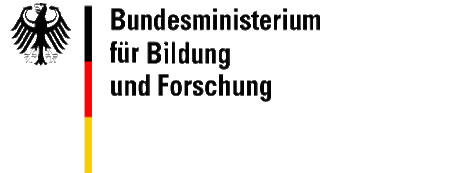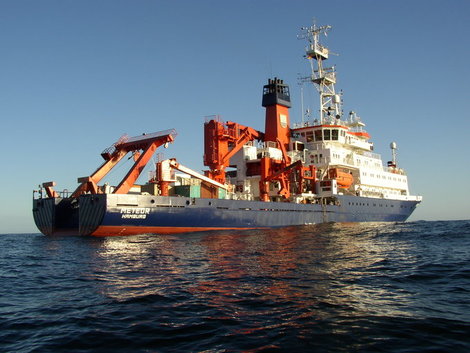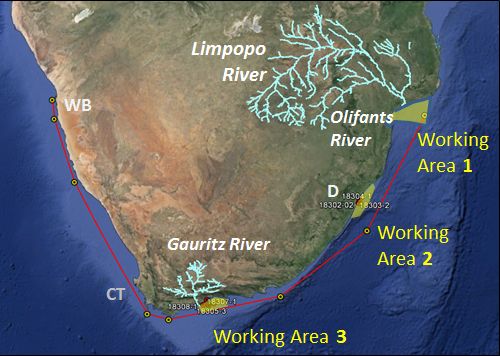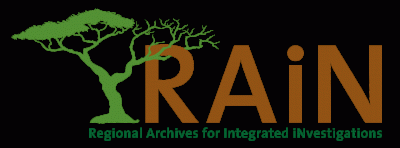Page path:
- Sediment Geochemistry
- Completed Projects (from 2005)
- RAiN
- RV Meteor M123
RV Meteor M123
Sediment deposits as archives for Late Quaternary climatic variations
The research activity of the underlying project RAiN focuses on the reconstruction of climate variations and dynamics in southern Africa during the Late Quaternary. Marine records, which are suitable to successfully edit this topic, almost only exist from the South African shelf along the Atlantic coast. The primary, scientific objective of expedition M123 is to retrieve appropriate sediment cores from the southern and eastern coast as well.
The sedimentation regimes along these shores are influenced primarily by strong contour currents, which cause rather erosive and sediment redistribution processes than accumulation and preservation. However, own pre-investigations during RV METEOR cruise M102 and former geomorphological investigations document that sediment packages of Holocene age can be found in a few restricted areas. Based on this information we defined three working areas where such deposits has been described (cf. Fig. below).
In addition to the sediment investigations in RAiN, planktonic foraminifera will be sampled. Their shells serve as an archive of the chemical and physical conditions under which they have been constructed. Thus, their actual presence in all marine environ-ments and ultimately in marine sediments, make these organisms important recorders of past ocean conditions.
Beside the scientific goals this expedition will put a strong focus on the training of young scientists and advanced students from Germany and South Africa.
In each of the working areas we want to start with acoustic surveys to identify the most promising sampling sites. Depending on the sediment structure and composition multi-corer, box corer, gravity corer or vibrocorer should be used to take samples from about 10 to 12 sites in each area. First investigations on board would include microscopy, light reflectance, sediment description, and subsampling for subsequent detailed analyses. To get a sufficient coverage of the whole operation area, one multinet should be deployment once a day if possible. Sampling as well as first processing of the sediment and particle sampled will be done together with the students. This practical part will be accompanied by small lectures for introduction to the specific geoscientific disciplines.
The sedimentation regimes along these shores are influenced primarily by strong contour currents, which cause rather erosive and sediment redistribution processes than accumulation and preservation. However, own pre-investigations during RV METEOR cruise M102 and former geomorphological investigations document that sediment packages of Holocene age can be found in a few restricted areas. Based on this information we defined three working areas where such deposits has been described (cf. Fig. below).
In addition to the sediment investigations in RAiN, planktonic foraminifera will be sampled. Their shells serve as an archive of the chemical and physical conditions under which they have been constructed. Thus, their actual presence in all marine environ-ments and ultimately in marine sediments, make these organisms important recorders of past ocean conditions.
Beside the scientific goals this expedition will put a strong focus on the training of young scientists and advanced students from Germany and South Africa.
In each of the working areas we want to start with acoustic surveys to identify the most promising sampling sites. Depending on the sediment structure and composition multi-corer, box corer, gravity corer or vibrocorer should be used to take samples from about 10 to 12 sites in each area. First investigations on board would include microscopy, light reflectance, sediment description, and subsampling for subsequent detailed analyses. To get a sufficient coverage of the whole operation area, one multinet should be deployment once a day if possible. Sampling as well as first processing of the sediment and particle sampled will be done together with the students. This practical part will be accompanied by small lectures for introduction to the specific geoscientific disciplines.
Funded by

Ref. No. 03F0731A
|
Phone: |
|
|
Email: |
|
|
Room: |
NW2-C 2350 |


groups involved:
- MARUM, Bremen University
- Dept. Geosci, Bremen University
- Inst. for Geosci., F.S.University Jena
- School of Chemistry, Univ. of Witwatersrand Johannesburg
- School of Agricultural, Earth and Environ. Sci., Univ. of KwaZulu-Natal Durban/Pieternmaritzburg
- Council of Geosci., Mar. Geosci. Unit
- Dept. Geol. Sci., Univ. of Cape Town
- Dept. Environ. & Geogr. Sci., Univ. of Cape Town

Equipment:
- Gravity corer
- Vibrocorer
- Multicorer
- Giant box corer
- Multinet





